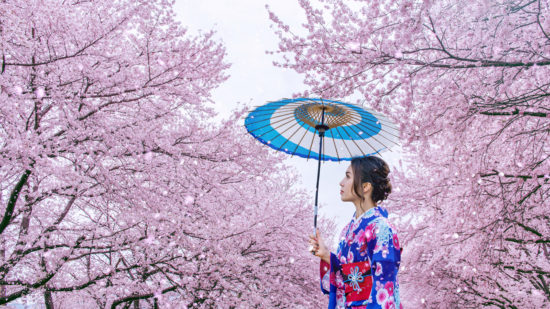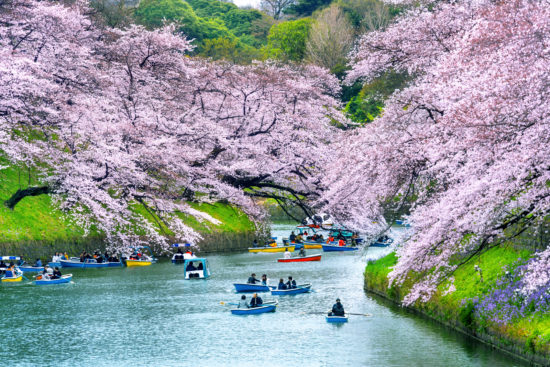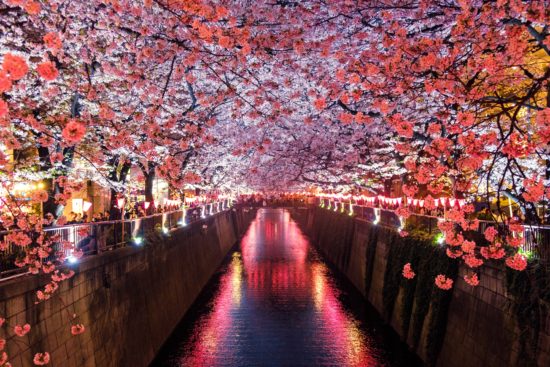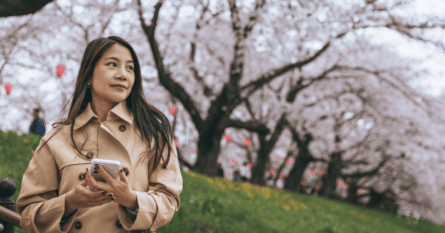Estimated reading time: 7 minutes
Imagine a sea of pink and white flowers, as far as the eye can see. For centuries, the cherry blossom has been a symbol of Japan’s culture and history, and its beauty has been celebrated in poetry, art, and literature. Here’s everything you need to know about this awe-inspiring seasonal event for your next visit to Japan.

Cherry blossom season in Tokyo is a time of great beauty and tradition. The city is home to many parks and gardens that are filled with cherry blossom trees, known as “sakura” in Japanese. During this time of year, the trees burst into pink and white blossoms, creating a breathtaking sight that attracts thousands of visitors from around the world.
Let’s embark on a journey through the cherry blossom season in Tokyo and discover how this delicate flower has become a symbol of the country’s culture and history.
A deeper look into the history and symbolism of cherry blossoms in Japan
The cherry blossom tree is native to Japan and has been a symbol of the country’s culture and history for centuries. The earliest written records of cherry blossoms in Japan date back to the 8th century.
During the Heian period (794-1185), the cherry blossom became a symbol of the imperial court and was often depicted in courtly literature. In the Edo period (1603-1868), the custom of ‘Hanami’, or flower viewing, became popular among the common people. During this time, people would gather under the cherry blossom trees to enjoy picnics and parties, and the blossoms were often used as a motif in art and literature.
During the Meiji period (1868-1912), Japan began to open up to the Western world, and cherry blossoms were introduced to countries around the world. The U.S. received its first cherry blossom tree as a gift from Japan in 1912, and since then, it has become an important symbol of the friendship between the two countries.
Today, cherry blossoms are celebrated in other parts of the world where the trees are grown, such as Sweden, Spain and Canada, and it has become an important symbol of spring.
Cherry blossoms are also rich in symbolism, they represent the transience of life, reminding us that we should cherish and appreciate every moment, as the blossoms bloom for a short period of time, usually around two weeks, and then they fall to the ground. Additionally, the cherry blossom is a symbol of renewal and hope, reminding us that new beginnings are always possible and that there is always hope for the future. The cherry blossom is also a symbol of love and affection. The delicate and ephemeral beauty of cherry blossoms is often associated with young love, and it is a popular flower for giving to loved ones in Japan.
Cherry blossom season traditions
Hanami
Hanami is a traditional Japanese activity that takes place during cherry blossom season. The word “Hanami” literally means “flower viewing” and refers to the practice of enjoying the beauty of the cherry blossoms. It is a time when friends and family gather together and have a picnic under the trees. It is a time to relax, socialize and appreciate the beauty of nature. This tradition has been practiced for centuries in Japan, and it continues to be an important part of the culture to this day.

During Hanami, people often bring bento boxes and drinks to enjoy under the cherry blossoms. Many parks and gardens in Tokyo hold special events during Hanami season, such as traditional Japanese music and dance performances, tea ceremonies, and food trucks selling Japanese snacks.
Yozakura
Yozakura means “nighttime cherry blossoms”, and as the name suggests this tradition happens during evening time. The cherry blossoms are illuminated at night, creating a magical and enchanting atmosphere. This tradition is an opportunity for people to enjoy the beauty of the cherry blossoms in a different way, and to see the blossoms in a new light.
Some parks and gardens have their cherry blossoms illuminated with colored lights that make the blossoms look even more mesmerizing. Cherry blossom illumination usually begins around sunset and lasts until late at night, allowing visitors to enjoy the view even after the sun goes down.

In addition to the traditional Yozakura events, many cities and towns also organize other activities such as light shows or illumination of other buildings and landmarks, making it an even more exciting and unique experience.
Best place to see cherry blossoms in Tokyo
Shinjuku Gyoen National Garden
Shinjuku Gyoen National Garden is a large public park located in the Shinjuku district of Tokyo. The garden is renowned for its beautiful landscaping and diverse collection of plants and trees. It is home to over 1,500 cherry blossom trees of various types, making it one of the most popular places in Tokyo. Visitors can stroll through the garden’s many paths, enjoying the beauty of the cherry blossoms and other flowers. The garden is divided into three main areas: a traditional Japanese garden, a French formal garden, and an English landscape garden, showcasing the different styles of gardening and horticulture.

The park also includes a large greenhouse that houses tropical and subtropical plants, a teahouse, and a traditional Japanese palace. Shinjuku Gyoen National Garden is a perfect place to relax and escape the hustle and bustle of the city, it’s a great place for people of all ages to enjoy nature, and it’s a must-visit destination for any traveler during the cherry blossom season.
Ueno Park
Another popular (and crowded) spot for cherry blossom viewing is Ueno Park. It is one of the oldest public parks in the city, known for its rich history, beautiful gardens, and cultural attractions. The park is home to over a thousand cherry blossom trees, making it the ultimate spot for viewing the cherry blossoms during springtime. As per the locals, the trees here bloom a little earlier than elsewhere.
There are several other attractions in Ueno Park, including a lake, the Ueno Zoo, the Tokyo National Museum, and the National Museum of Western Art.
Ueno Park also features several temples, shrines, and monuments. Bentendo Temple is a small temple located on an island in the middle of Shinobazu Pond, it’s a popular spot for taking pictures and enjoying the beautiful surroundings. Kaneiji Temple is another temple inside the park, it was one of the wealthiest temples in Japan’s history and it also has a beautiful cherry blossom garden.
Chidorigafuchi
Chidorigafuchi is another popular cherry blossom spot located in the heart of Tokyo. It is a moat that surrounds the Imperial Palace, and it is lined with over 200 cherry blossom trees. The moat is filled with a beautiful sea of pink and white flowers in the spring season, which draws thousands of visitors each year. There are also rental boats available for visitors who would like to take a leisurely paddle on the moat and enjoy the blossoms from the water.
We suggest you visit the Chidorigafuchi Greenway, a pedestrian path that runs along the moat. Almost like a ‘Sakura tunnel’, the path is lined with cherry blossom trees. There are many food trucks and souvenir stands selling Japanese snacks and traditional gifts on the path.
At night, the blossoms are illuminated, creating a magical and enchanting atmosphere, making it a perfect spot for a romantic night stroll.
Yasukuni Shrine
Another popular place to view the cherry blossoms in Tokyo is the Yasukuni Shrine, which is a Shinto shrine. Shinto shrines are sacred places of worship in Japan and are dedicated to the kami, or spirits, of the natural world. These shrines are characterized by their torii gates, which mark the entrance to the sacred area, and are typically surrounded by nature, such as trees and water.
Yasukuni Shrine is dedicated to the spirits of Japan’s war dead, including those from the Meiji period, World War II, and other conflicts. The shrine was established in 1869 by Emperor Meiji and it has been a place of pilgrimage for the Japanese people for over 150 years. The shrine’s grounds are home to over a thousand cherry blossom trees, making for picturesque shots and picnics.
In addition to the cherry blossoms, the shrine also features several other buildings and structures, including the main hall and the museum of military history. Yasukuni Shrine is an important symbol of Japan’s military past and a reminder of the sacrifices made by the country’s war dead.
Find the best accommodations
Of course, before you visit any landmarks or try some new food you’ll need a place to stay. Luckily, we’ve got you covered with the best hotels by neighborhood in our article on where to stay in Tokyo and the best spots for those traveling for work in the best business hotels in Tokyo.
How to get around Tokyo
Tokyo is a bustling metropolis known for its crowded streets and busy atmosphere. Navigating the city can be challenging, especially if you are unfamiliar with the area. Taxis are also quite expensive in Tokyo, which can make getting around the city a costly endeavor. which is why we advise that you book a reliable Blacklane car service in Tokyo to get you to your destination in style. When you download the Blacklane app, you’ll get access to local chauffeurs who know the best route to take. Beyond just the language, your Blacklane chauffeur can help you navigate some of the cultural and even infrastructural differences you’ll face on arrival.


